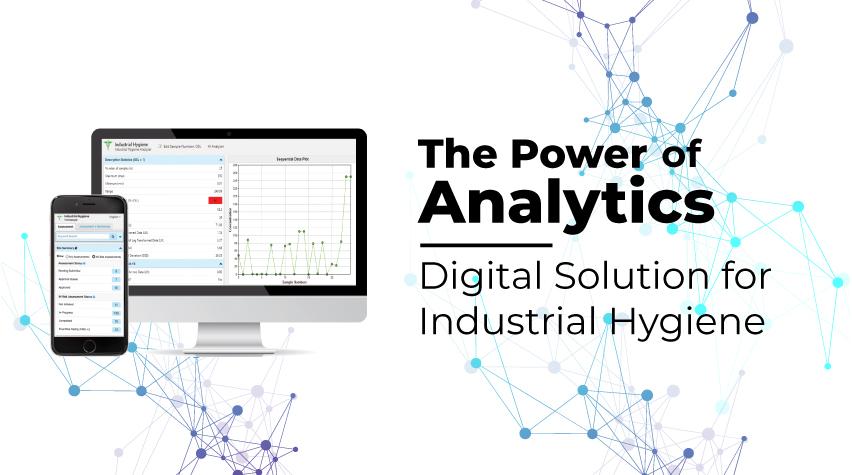
This content is provided by Gensuite and reflects their views, opinions, and insights.
Insights derived from data analytics are empowering organizations large and small to make key business decisions that often transform their organization or program practices. Offering a look into financial savings opportunities, risk mitigation, health and safety improvements, compliance tracking, and more, data analytics provide a holistic view of operations to develop future focused business strategies.
As a growing emphasis is placed on health, safety, and employee/workplace exposure to risks in the current pandemic environment, organizations focused on occupational health and industrial hygiene can increase productivity and employee health using this digital data. Capturing, tracking, and analyzing robust data sets enables organizations to proactively manage a safer, healthier, and more incident-free workplace.
According to the US Bureau of Labor Statistics, there were 2.8 million nonfatal workplace injuries and illnesses in 2018, accounting for over 900,000 days away from work and leading to an estimated $170+ billion in work injury costs, based on a National Safety Council cost estimate of income not received or expenses incurred. Data mining and trend analysis through analytics tools are helping organizations in their quest to reduce these numbers.
Saving time and mitigating risk
Manually analyzing data is a tedious process, involving hours of prep work to compile data from multiple, disconnected sources, often redundant or lacking viable information to translate into actionable insights. And when health and safety improvements are the end goal for data analysis, organizations often can’t afford to spend hours coordinating manual data analysis efforts that require continual updates for on-going results.
Digitizing data analytics enables organizations to access real-time data in seconds, compiling and cross-referencing multiple sources to provide in-depth data mining and predictive analysis across all levels of an organization. Data analysis more specifically concerning occupational health and industrial hygiene can be used to capture risk and hazard assessments, engineer controls, and leverage automated occupational or personal exposure limits. Through customizable, easy-to-use logs for monitoring data, organizations are saving time while simultaneously reaping the benefits of an automatic, digital system to conduct industrial hygiene risk assessments to increase the health and safety of their workplace.
Occupational health solutions to manage data analytics
Implementing an integrated suite of digital occupational health solutions provides organizations with a set of tools to manage and track health and safety exposure risks, as well as the infrastructure to begin digital data mining. Organizations can benefit from standardized medical, case management, and injury and illness data utilizing comprehensive assessments that enable scheduled follow-up tasks, centralized record keeping for occupational health teams, as well as the increase in visibility of worker care with reporting and actionable insights. With built-in, standardized assessments feeding directly to reporting software, future injury and illness incidents can be mitigated by performing root cause analysis and identifying statistical likelihood of overexposures through data monitoring.
Gensuite offers a complete suite of occupational health solutions to manage worker care and mitigate injuries and illnesses from hazardous exposures. The integrated suite features tools such as Med Care, to simplify medical clinic recordkeeping for collaboration, treatment, and follow-up care; Industrial Hygiene to track and analyze exposures assessments and monitor summaries; Ergo Evaluator to standardize ergonomic assessments for improvement identification and risk mitigation; PPE Manager to manage critical personal protective equipment for vital restocking; and Incident & Measurements to record all incidents by type, enable follow-up, and root cause analysis to analyze metrics and trends. Together, these applications offer a complete solution for managing occupational health while tracking data for follow-up and analysis.
Take charge of your industrial hygiene data
Leveraging data analytics to mitigate risk and increase the health and safety of workers, Gensuite’s Industrial Hygiene application offers many ways for organizations to look at their data in a meaningful way to characterize risk for their employees. And with over 1,200 industrial hygiene assessments completed in the first half of 2020 alone, organizations are taking advantage of the tools at their disposal.
Featuring customizable risk assessments and logs as well as industrial hygiene monitoring and sampling by employees, work area, or bulk, this information can be tracked and analyzed with built-in reports to data mine by various attributes such as exposure groups or limits, risk level, and more. With an enhanced analyzer report, the module incorporates guidance systems and structures to help users read the reported results for a more in-depth and critical analysis. In addition to the in-built reporting tools within the Industrial Hygiene module, the integrated Analytics module powered by Tableau® brings data to life with pre-designed reports, filterable by your unique needs to generate organizational performance, and KPI reports using data from all the applications within the Occupational Health suite.
As data continues to play a more increasing role in business operations, decision making, and health and safety, a digital solution for data analysis and mining is an organization's best asset. Combating the injury, illness, and exposure risks of today’s world can keep organizations viable with access to medical surveillance, monitoring, reporting, and transparency, now and into the future. Learn more about Gensuite’s Occupational Health suite of solutions, including the Industrial Hygiene application.
 Disclosure: This post is sponsored by Gensuite and reflects their views, opinions, and insights.
Disclosure: This post is sponsored by Gensuite and reflects their views, opinions, and insights.


